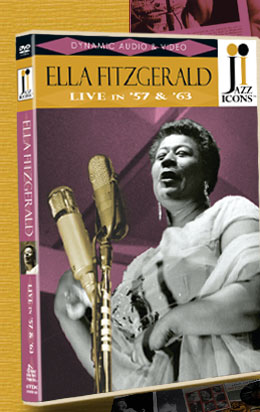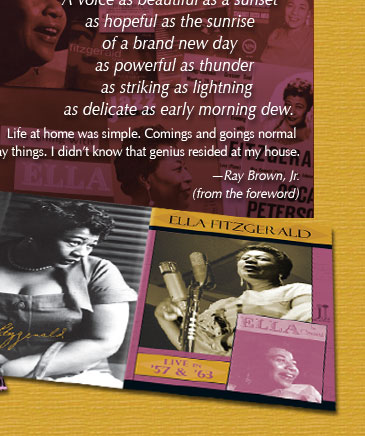




 |
 |
|
|||
|
|
|
||||
|
|
|
||||
|
|
|
||||
|
|
|
||||
 |
|
||||
 |
|
||||
 |
|
||||
|
|
|
|
|
|
|
 |
 |
 |
 |
Jazz Icons: Ella Fitzgerald features “The First Lady Of Song” in two distinct performances. The first is the earliest known complete concert of Ella to be captured on film. Shot in Belgium, this 1957 concert has her performing with jazz greats Ray Brown, Herb Ellis, Jo Jones and the legendary Oscar Peterson on classics such as “Lullaby Of Birdland,” and “It Don’t Mean A Thing (If It Ain’t Got That Swing).” The second show is an intimate in-studio performance from 1963, taped in Sweden, featuring Ella backed by a quartet including pianist Tommy Flanagan. Highlights include stellar versions of “Mack The Knife” and “Just One Of Those Things.” |
|
 |
|
|
Vocal- Ella Fitzgerald Piano- Don Abney Bass- Ray Brown Drums- Jo Jones Guitar- Herb Ellis Additional Personnel on “It Don’t Mean A Thing (If It Ain’t Got That Swing)” Trumpet- Roy Eldridge Piano- Oscar Peterson |
Angel Eyes Lullaby Of Birdland Love For Sale Tenderly April In Paris Just One Of Those Things Roll ‘Em Pete I Can’t Give You Anything But Love It Don’t Mean A Thing (If It Ain’t Got That Swing) |
 |
|
|
Vocal- Ella Fitzgerald Piano- Tommy Flanagan Bass- Jim Hughart Drums- Gus Johnson Guitar- Les Spann |
No Moon At All Just One Of Those Things Runnin’ Wild Georgia On My Mind Desafinado Hallelujah, I Love Her So Mack The Knife |
16-page booklet Foreword by Ella's son Ray Brown, Jr. Liner notes by Will Friedwald Cover photo by Paul Hoeffler Booklet photos by Ted Williams, William "PoPsie" Randolph, Susanne Schapowalow, Herman Leonard, Jamie Hodgson Memorabilia collage Total time: 56 minutes |
|
|
Foreword: Life at home was simple. Comings and goings normal everyday things. I didn’t know that genius resided at my house. It was just Mom— “Do your homework, clean your room,” Mom. Yes, it was cool being backstage, but that’s because not everybody could be backstage. I was dragged onstage a couple of times to dance with my mom, but c’mon, there were things going on backstage. Arlie (Smalls) had her hands full trying to keep me in check. Pete (Carvallo) was never the enforcer, but things did mellow out with his “you’re OK.” ... But as I peeked out from behind the curtain a bit, I could see it wasn’t just my heart that was being touched. I graduated from backstage to front rows because I wanted to. I had to see and feel and be a part of the experience that everybody else was enjoying. ... Can you imagine a planet without the heart and soul and groove and love of the musical giants that reside among us? Many talents will never have an equal, but the real joy is their inspiration—their encouragement. We can enjoy and learn and, in our own various ways, give. That is what they all did. As you watch and remember, I hope you will appreciate that my mother gave all she had. —Ray Brown, Jr. • June 2006
Sample Liner Notes by Will Fridwald: Ella Fitzgerald’s awe-inspiring musical abilities were seemingly super-human: her sense of time and her pitch were impeccable. It is no wonder she was frequently perceived as something supernatural: an angel, a spirit or a divine muse. It is here, within the two rarely seen performances captured on DVD that we see Ella Fitzgerald in all her glorious humanity—performing live. ... Although Fitzgerald was recorded frequently in this period, no document, audio or video, has been officially released from her European tour in 1957, until now. The first concert on this DVD was filmed in Belgium, and although there are earlier and much shorter snippets of Ella in performance, this is probably the best recording of The Great Lady in concert from this era. The supporting cast is especially strong: longtime accompanist Don Abney on piano, the pioneering modern jazz bassist Ray Brown (who was also her ex-husband), the outstanding guitarist Herb Ellis and, as a special treat, one of the most celebrated drummers in jazz history, “Papa” Jo Jones, best known for his long tenure with the original Count Basie Band. Throughout the concert, Jones looks down from his drum stand positively beaming as Fitzgerald sings. The show begins with “Angel Eyes,” Fitzgerald’s signature ballad of the era and a classic vehicle that reveals the full extent of her great gift as an interpreter of lyrics and emotions. Composer Matt Dennis once said the first time he played the song for her she knew immediately she wanted to use it as an opening number. Dennis, who had the honor of hearing his masterwork interpreted by Frank Sinatra and Nat King Cole, said Ella’s performance was easily his favorite. Next is George Shearing’s most celebrated composition, the up-tempo “Lullaby Of Birdland,” which she was able to sing thanks to a lyric by Tin Pan Alley pro George David Weiss. “Lullaby,” a nonsensical, nursery rhyme of a text, sounds completely logical in Fitzgerald’s rendition. Although this song provided the title for what may be her all-time best album Lullabies of Birdland – a collection of famous early scat numbers—“Lullaby” itself was not an extended scat feature for her, but later became a scat extravaganza for Fitzgerald’s disciple Mel Torme. ... The second amazing performance captured here features Ella in a 1963 Swedish television appearance. Four years prior, Granz had sold off his interest in Verve to MGM Records. Although he continued to produce Fitzgerald’s recordings, the new owners thought they had plenty of live performances by Fitzgerald in the can. As usual, Fitzgerald was constantly on the road all over the world, but there are few live concert recordings from the early ’60s. The 1963 Swedish performance is an exclusive in many aspects: here is the first recording of Fitzgerald with her new pianist, Tommy Flanagan (this is the only document of this particular edition of the trio with Flanagan), drummer Gus Johnson (another long-time Basie-ite) and bassist Jim Hughart, and it is the only visual concert performance from the period. One of the great assets of the first Belgium show is that it was filmed in a concert hall with a live audience. Everywhere you turn, the hall is so packed there are at least a hundred people right up on the stage, sitting behind Ella and the trio, and looking at the back of her head. In Stockholm, Fitzgerald and company perform in a television studio, and even though an audience is audibly present, they are never seen. Visually, the quality is superb. The show was recorded on videotape (whereas the Belgian show was shot on film) and there are lots of tight close-ups of Ella’s face in mid-song, which provide an intimacy unmatched in a concert hall or nightclub. The visual nuances are also fascinating—such as when Fitzgerald refers to “fancy gloves” in “Mack The Knife” while she pantomimes the action of straightening a pair of elbow-length gloves. The most exciting thing about the 1963 concert is Fitzgerald’s enthusiasm; she is quite literally overflowing with energy. As Tony Bennett once put it, “Ella couldn’t wait to get out there and start entertaining the people.” At this show in particular, Fitzgerald is supercharged from the opening note, possibly even more so than six years earlier. The tempo is relentless on the fast numbers, similar in feel to Ella’s then-recent album, Rhythm Is My Business, and the intensity is palpable—even on the ballads. All words and artwork on this page ©Reelin' In The Years Productions. Unauthorized use is prohibited.
|
|
Site contents ©Copyright 2006 Reelin' In The Years Productions
Site designed by Tom Gulotta